Green curry is one of the most famous dishes of Thai cuisine, and my #1 most popular recipe on YouTube. But over the years I’ve had many people ask how to make it vegan without compromising on flavour.
Sure, you can just sub some tofu for the meat and add salt instead of fish sauce, but to make a really great vegan Thai green curry recipe, one that will satisfy even meat eaters, we gotta go a little further!
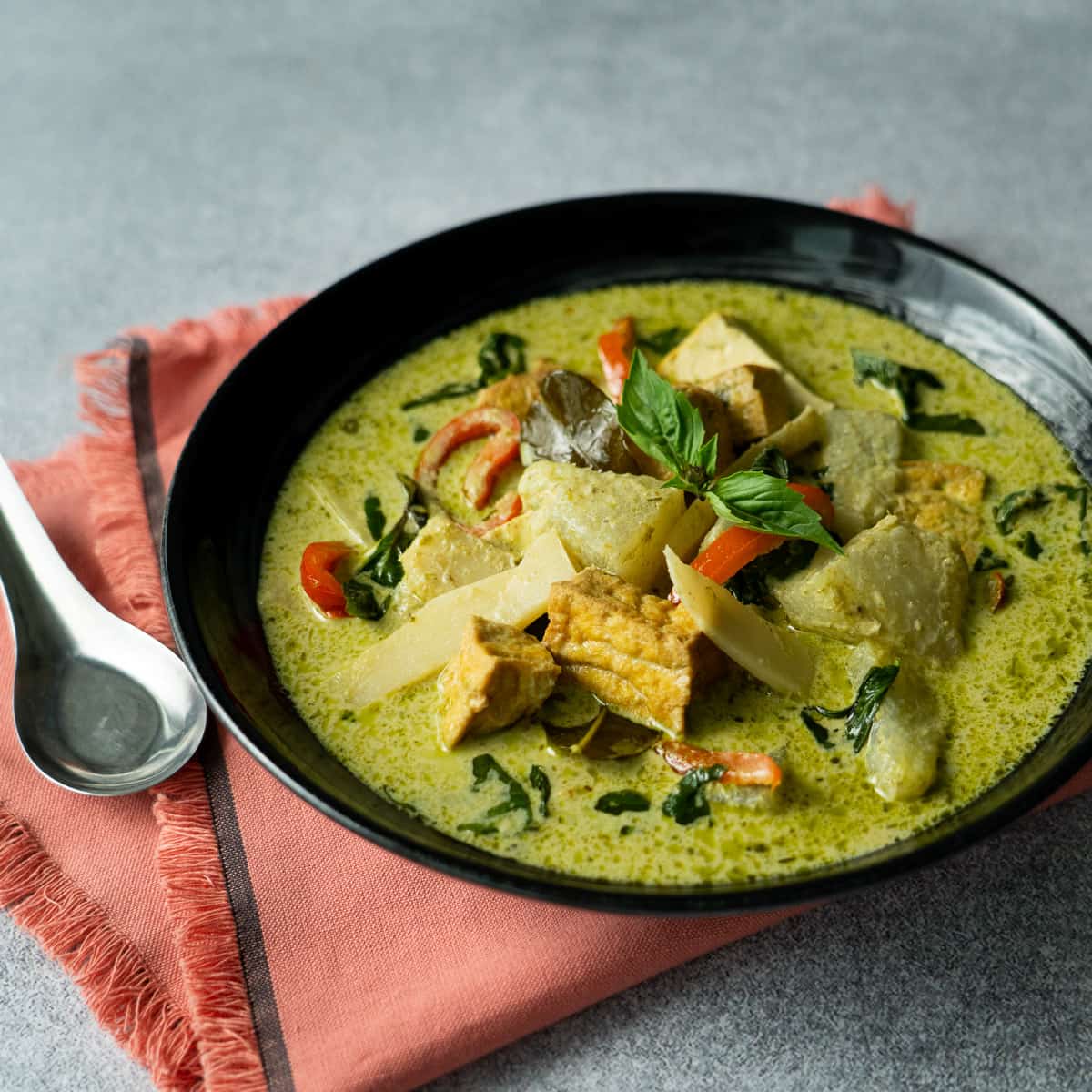
Want to save this recipe?
How to Make a Vegan Thai Curry without Compromising on Flavour
Many people on plant-based diets are drawn to Thai food because we don't eat as much meat as in a Western diet, and the meat usually comes in small pieces rather than a big hunk that's the center of the meal. But many are also surprised by how much animal products are hidden in Thai food! Fish sauce, shrimp paste, oyster sauce, dried shrimp, and even ground up fish added to thicken our sour curry.
So when we remove meat and animal products from a Thai curry, we’re also removing a couple of important things. First, the umami - that rich, savoury flavour we all love. Second, the chewy texture - a key ingredient in a dish that feels substantial and satisfying.
So when I make a vegan dish, these are my two goals:
- Pack it with plant-based umami flavor, as without this the dish will taste “weak.”
- Choosing ingredients with a substantial chew. If you don't, it’ll taste like a side dish rather than a complete, hearty meal.
Want more ideas for vegan Thai curries? Try my vegan Thai red curry recipe and also this yellow curry cauliflower stir fry.
Ingredients
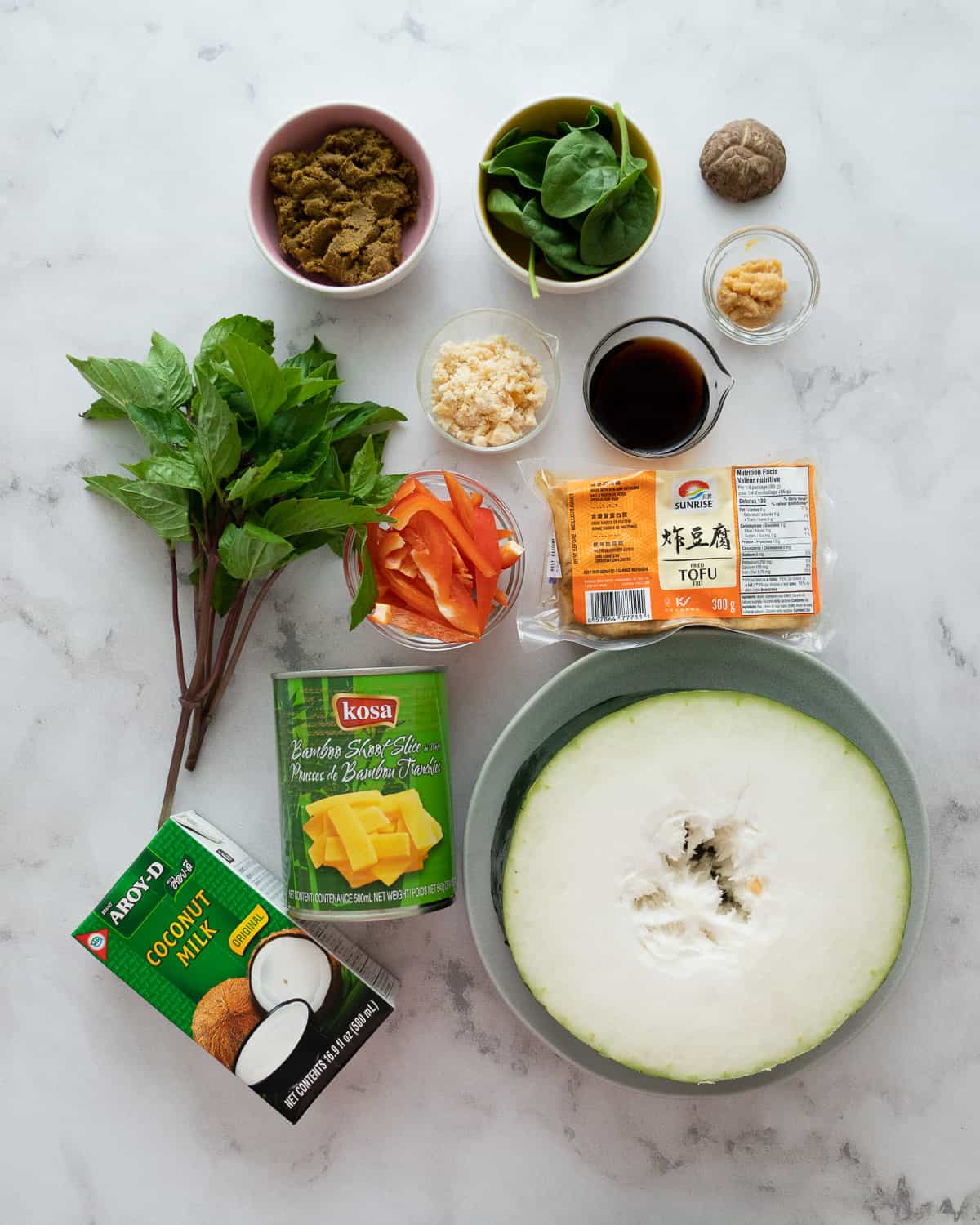
For “better” vegan green curry paste:
If you're feeling ambitious, you can make the curry paste from scratch using my homemade green curry paste recipe. But rest assured that store bought curry pastes are perfectly fine; however adding a few key ingredients will make it even better.
- Green curry paste. Many grocery stores, even non-Asian ones, carry green curry paste, but you need to read the ingredient list to make sure it does not contain shrimp paste or fish sauce.
- Miso paste. Traditional Thai curry pastes have fermented shrimp paste (gapi) added for umami, but many store bought pastes leave this out to make it vegetarian-friendly. Adding miso puts the umami flavour back in without the shrimp.
- Dried shiitake mushroom. A rockstar in Asian vegan cooking, dried shiitake mushrooms are loaded with umami, and a key ingredient in my vegan Thai red curry recipe. We can easily grate this right into the curry paste using a microplane.
- Leafy greens such as baby spinach or Thai basil. Green curry gets its colour from green chillies, but most commercial pastes don't add a lot of green chillies to keep it from being too spicy, so the curry paste ends up a bit pale. Adding greens is how we can boost the colour without adding more heat! Spinach breaks down easily in a mortar and pestle so it's become my go-to, but any other greens will work.
PS. This is not "my hack," it is something Thai people routinely do using whatever leafy greens are available.
For the vegan green curry
- Coconut milk. Use full-fat coconut milk; coconut milk's flavour is in the fat, so light coconut milk is also light in flavour! Watch this video for a guide to choosing coconut milk.
- Water or unsalted vegetable stock; but avoid vegetable stocks with a strong flavour or very dark colour which can clash with the curry.
- Palm sugar, coconut sugar, or light brown sugar.
- Soy sauce or vegan fish sauce.
- Fried tofu (pic below). I choose fried tofu because the skin is chewy, adding to the substantial feel of the curry. Your local Asian market probably sells it pre-fried, but you can also buy firm or extra firm tofu and fry it yourself just until a golden brown skin is formed. Any other vegan protein that is chewy can be used instead.
- Bamboo shoots strips, canned. Another firm vegetable you have to chew that's easy to use! You can substitute another firm, crunchy vegetable such as baby corn, al-dente-cooked green beans, or sugar snap peas.
- Winter melon or thai eggplant. Some softer veggies to complete the curry. Winter melon and Thai eggplant are classic pairings with green curry, but you can sub other vegetables of your choice here.
- Red bell pepper for some colour.
- Thai basil leaves, or regular fresh basil.
- Makrut lime leaves (kaffir lime leaves). This is optional; don't sweat it if you can't find it. Most store bought curry paste already has makrut lime zest in it.
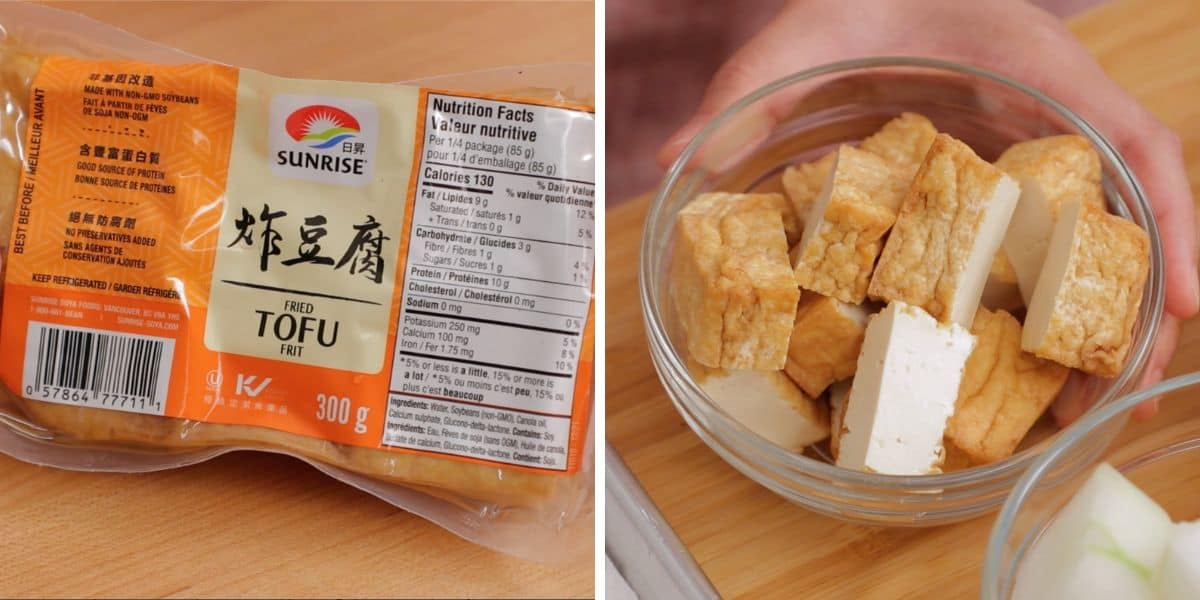
Instructions
This is an easy recipe, and perfect for Thai food beginners. Here's an overview of the steps, but be sure to check out the full recipe card and also watch the video tutorial to ensure success!

- In a mortar and pestle, grind the leafy greens into a fine paste.
- Add the miso paste, then use a microplane zester to grate the shiitake mushroom (don’t worry about grating the stem; you can add it to the curry to extract more umami if you want, but don’t eat it as it’ll be chewy.)
- Add the curry paste and pound just to mix. You can make this paste in bulk and freeze for later use.
- In a large pot, add about ¾ cup of coconut milk and reduce it over medium-high heat until thick; about 5 minutes.

- Once thick, turn it down to medium heat and add the curry paste.
- Stir until very thick and the coconut oil separates from the curry paste; 3-5 minutes.
- Add the rest of the coconut milk and water; bring to a boil.
- Add the fried tofu, bamboo shoots, winter melon, palm sugar, and half of the soy sauce. Grab the makrut lime leaves and twist them to bruise and tear before adding them into the pot. Simmer the curry until the winter melon is fork tender; about 10 minutes.
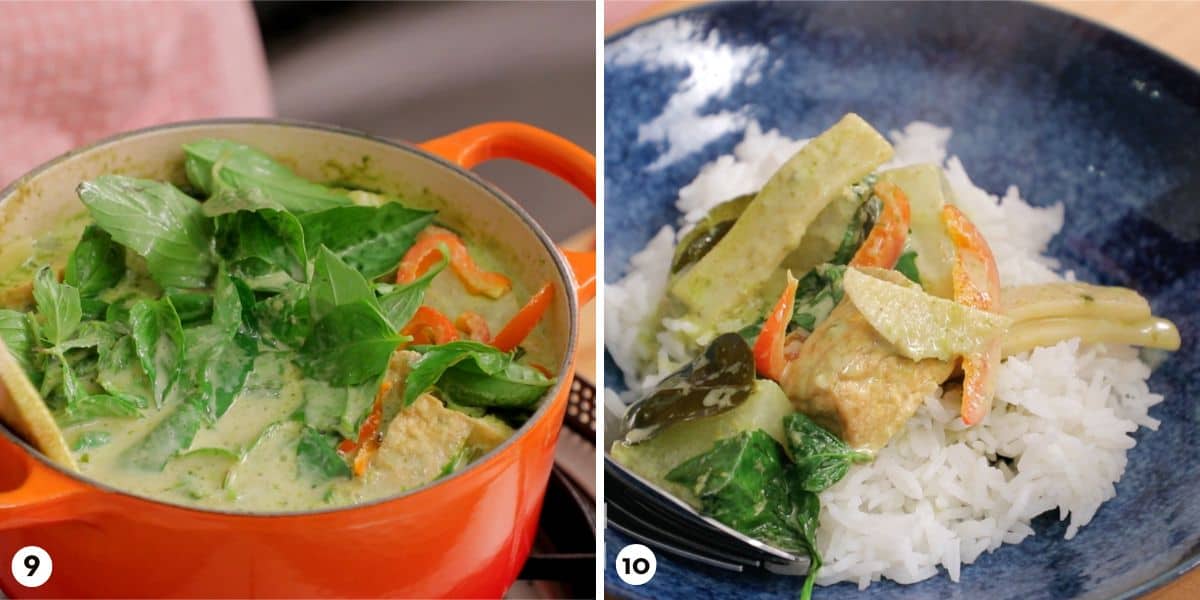
- When you’re about 1 minute out, add the red bell pepper so it will finish cooking with the winter melon. (If using different vegetables, see the full recipe for how to adjust cooking time.) Taste and adjust the seasoning, then turn off the heat and stir in fresh basil, letting it wilt in the residual heat.
- Serve with jasmine rice - and as with most Thai curries, it will taste even better the next day!
Pro-Tip: Ordering Vegetarian Curries in Thai Restaurants
Thai curries are usually seasoned with fish sauce, and some brands of curry pastes contain shrimp paste. While many Thai restaurants will be happy to make you a "vegetarian curry" when asked, I suggest also asking them whether there is fish sauce or shrimp paste in it. Many Thai cooks are not familiar with plant-based diets, so they may not think to mention these hidden ingredients.
Most Thai restaurants also make their curry sauce in advance, so unless they add the fish sauce to order (unlikely, but possible), they cannot modify their sauce to make it vegan for specific orders.
Storage Tips
Herbs and spices in Thai curries are natural preservatives, so in an airtight container in the fridge, this will last you at least a week, and probably longer, making this a great recipe for meal prep!
If you want to freeze it, I recommend freezing just the green curry sauce and the bamboo shoots, because freezing veggies and tofu will affect their texture when thawed.
Frequently Asked Questions
Coconut cream will make this curry very rich. If that's what you want, go for it, but if you want to keep the same richness profile, use about 40% less of it and add more water to make up for the volume.
From experience I know that Aroy-D, Maesri and Thai Kitchen brands do not contain shrimp paste. Maeploy, though is my favourite in terms of flavour, does contain shrimp paste. Exported versions to different countries may differ, so always read the ingredient list!
Yes, of course! But I chose to show adding these ingredients to the curry paste because it's useful to make this paste in bulk and freeze so you don't have to do this every time. If making a lot, you can grind the shiitake mushroom up in a food processor or a blender instead of using a microplane.
Absolutely. I always freeze opened curry paste that I have no immediate plans for. While it will last a long time in the fridge, freezing ensures that flavours of the herbs and spices remain intact for longer. I freeze it in the plastic tub that it comes in, but you can transfer it into a mason jar or a freezer bag.
Before you start, watch the video tutorial to ensure success! Especially if you're new to Thai cooking, it is always helpful to see it in action. The video is in the recipe card below, but you can also watch it on YouTube!
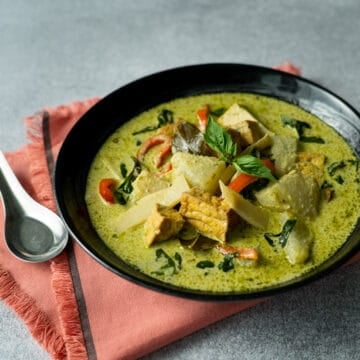
Vegan Thai Green Curry
Equipment
- mortar and pestle or a blender (both optional)
Ingredients
For an "improved" vegan curry paste
- ¼ cup green curry paste, store bought or homemade (see note 1)
- 10-15 leaves of greens such as baby spinach or Thai basil, finely julienned (see note 2)
- 1 dried shiitake mushroom, medium size, about 5-6 g
- 2 teaspoons miso paste
For the vegan green curry
- 2 cups coconut milk
- 1 cup water
- 7 oz fried tofu, bite-sized pieces (see note 3)
- 5.3 oz canned bamboo shoots strips, drained and rinsed well (half a can)
- 9 oz winter melon, 1-inch chunks (see note 4)
- 1 tablespoon palm sugar, finely chopped, or substitute brown sugar
- 2 tablespoon soy sauce, or vegan fish sauce
- 6 makrut lime leaves, optional
- ½ red bell pepper, julienned (optional for colour)
- 1 cup Thai basil leaves
- Jasmine rice, for serving
Want to save this recipe?
Notes
- The amount of curry paste provided is just a guide. You can add more if you can tolerate more heat, or add less next time if you find this too spicy. Adding more will also add more flavour, but keep in mind that curry paste contains salt, so be prepared to adjust the amount of soy sauce accordingly.
- Baby spinach I find is breaks down most easily in a mortar and pestle, but any leafy greens will work.
- You can buy fried tofu at Asian grocery stores. If not available, you can get firm or extra firm tofu and fry it yourself until a golden brown skin forms. Another chewy vegan protein can be substituted.
- Thai eggplant is another great vegetable to use instead of winter melon. You can also sub another softer vegetable such as zucchini.
FULL VIDEO TUTORIAL
All my recipes come with step-by-step video tutorials with extra tips not mentioned in the blog post, so make sure you watch the video to ensure success. If you enjoy them, consider subscribing to the YouTube Channel to not miss an episode. Thank you!
Subscribe to my YouTube ChannelInstructions
For the curry paste
- In a mortar and pestle, grind the leafy greens into a fine paste. Add the miso paste, then use a microplane zester to grate the shiitake mushroom (don’t worry about the stem. You can throw the stem into the curry to extract more umami if you want, but don’t eat it as it’ll be chewy.) Add the curry paste and pound just to mix. You can make this paste in bulk and freeze for later use.Without a mortar and pestle, you can blend the leafy greens with some of the coconut milk that you'll add to the curry. Then simply mix the curry paste, miso and grated mushroom together.10-15 leaves of greens such as baby spinach or Thai basil, 1 dried shiitake mushroom, 2 teaspoons miso paste, ¼ cup green curry paste
For the green curry
- In a heavy-bottomed, large pot, add about ¾ cup of coconut milk and reduce it over medium-high heat until thick; about 5 minutes.2 cups coconut milk
- Reduce the heat to medium and add the curry paste; stir until very thick and coconut oil separates from the curry paste; 3-5 minutes. (If you’ve been at it for a while, and the paste is very thick, but no oil has separated, you can move on; some coconut milk has been processed to prevent separation.)
- Add the rest of the coconut milk and water; bring to a boil. Add the fried tofu, bamboo shoots, winter melon, palm sugar, and about half of the soy sauce. Grab the makrut lime leaves and twist them to bruise and tear before adding them into the pot. Simmer the curry until the winter melon is fork tender; about 10 minutes. When you’re about 1 minute out, add the red bell pepper so it will finish cooking with the winter melon. (If using different vegetables, adjust the cooking time accordingly, but if your vegetables take only a few minutes to cook, let the curry simmer without it for at least 10 minutes before adding, as you want the total simmering time to be a minimum of 10 minutes to allow flavours to mingle.)1 cup water, 7 oz fried tofu, 5.3 oz canned bamboo shoots strips, 9 oz winter melon, 1 tablespoon palm sugar, 2 tablespoon soy sauce, 6 makrut lime leaves, ½ red bell pepper
- Taste and adjust the seasoning with more soy sauce as needed; you can also add more salt. If it needs more sugar, add granulated or brown sugar at this point to ensure it dissolves quickly. (It should not taste sweet, but the sweetness is added to balance the salt.)
- Turn off the heat and stir in fresh basil, letting it wilt in the residual heat.1 cup Thai basil leaves
- Serve with jasmine rice - and as with most Thai curries, it will taste even better the next day!Jasmine rice

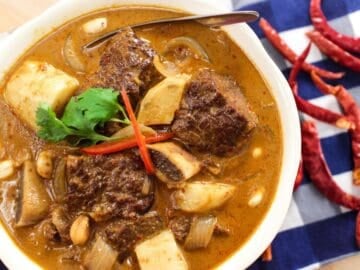
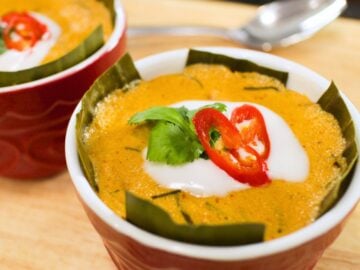
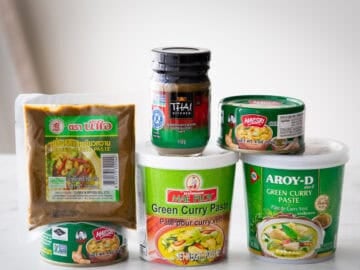
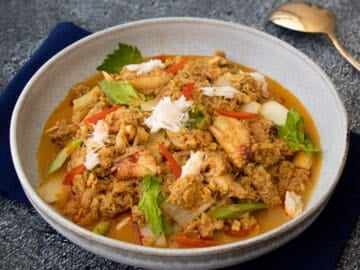
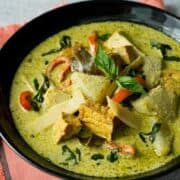
nicole says
I love this curry so much! I have made it numerous times already and it never dissapoints, an absolute banger everytime. It is definitly worth it to improve your curry paste as the recipe states, I made it once without improving the paste and you really notice the difference. It was still lovely but the deeper level of flavour was just missing. I highly recommend anybody to try this!
Miriam says
Thank you so much for taking the time to share not only the recipe and do a video tutorial but also explain the choice of ingredients!
Also I've never come across a vegetarian Green Curry Recipe that was truly authentic so understanding the "substitute" ingredients was key for me.
I'll be sure to share with my friends!
Vanessa says
Very tasty recipe- probably the best green curry recipe I’ve tried so far. I didn’t add any more than half the soy sauce but might actually do less than that next time. Wish I had the kaffir leaves but I couldn’t find them.
Rashmi says
I love your recipes. I want to introduce it to my son who has coconut allergy. Any substitute for coconut milk please.
Thank you
Pailin Chongchitnant says
Replace all of the liquid including water/stock with soy milk or oat milk and saute the curry paste in oil 🙂
Priya Kamath says
So delicious, to balance the heat I add some finely diced sweet potato. On the side I make your papaya salad and rice. Thankyou for all your recipes.
Ashley says
How is this vegan if you use green curry paste that contains fish or shrimp? You even mention this as a caution for ordering in restaurants, but then leave it in your "vegan" recipe?
Pailin Chongchitnant says
It would be vegan if you use curry pastes that don't contain shrimp paste, of which there are many brands on the market. I figured it was obvious that if you were vegan...you'd choose a curry paste that is...vegan.
Sarah says
This was AMAZING. I couldn't find wintermelon (next time!) but it came out amazing when using broccoli instead. Definitely adding to the regular rotation.
Robyn Kurtz says
I have never made a Thai curry that was more than "meh" and so i made this last night. Sadly it was still underwhelming to me! Which i fully think is me and not the recipe. Maybe it's my paste? I used Thai Kitchen. or maybe my coconut milk, because it didn't separate, so i will check out your tips.
Also i wasn't sure if i should wash the dried shitake mushrooom at all so i wiped it with a damp towel, but then it would't grate so i buzzed in in my food processor and it never got as small as grating would have made it. maybe that was the issue? i don't know but will definitely try again because it was better than ones i have made previously!!
I bought a bitter melon accidentally so instead of using that, i used some carving pumpkin i had waiting for me to use, it was a really good veg for this because it sucked up the flavour, but i can't wait to try a winter melon!
i really appreciated the video, it was so helpful and you are fun and funny and i will look to see if you have any more vegan recipes.
Dhvani J says
if you're using thai kitchen you have to double the amount because it's underwhelming
Sarah P says
This recipe was delicious, and very easy to make! I used a lot of veggies (a zucchini, carrots, snap peas, and greens) and there was still plenty of sauce and flavor. I didn't have lime leaves but I had some dried lime zest that helped give a little zing. I didn't have any Thai basil to stir in at the end, so I'll have to make it again with that, as I'm sure it makes the dish better, but we loved it as is!
Judith Hadley says
I made this and it is delicious!!! I used Thai basil rather than spinach and fried the tofu myself but other than that I stuck to your recipe.
Paul S. says
I've made this twice now, and it's been delicious each time. I cut the tofu into cubes and let them sit on top of a clean dish towel so some water gets drained from them. I also fry the cubes myself in a cast iron pan with avocado oil until they are nicely browned. The only other modification I've made is adding the juice of one or two limes at the end -- it really helps brighten up the curry. Oh, I also added sliced mushrooms. I've never cooked with Winter Melon before and it's a wonderful discovery. The tips on finding the best coconut milk were also very helpful.
Arie says
I made this last night and it was so delicious! Thanks for the tip on using spinach for color, miso for rich flavor and fried tofu for texture. We didn't even have to add hot sauce, the flavors were so perfect.